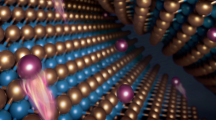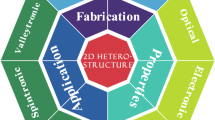Abstract
The control of hybrid interfaces in polymer-based electronic devices may be enabling in many applications. The engineering of hybrid interface involves (requires) an understanding of the electronic structure of materials—one organic and one inorganic—that form the two halves of hybrid interfaces, as well as the electronic and chemical consequences of the coupling of the two. Although much literature exists describing the interfaces between vapor-deposited organic molecules and model molecules for polymers on the surfaces of clean metals in ultrahigh vacuum, few studies have been reported on spin-coated, semiconducting polymer films on realistic substrates. Spin coating in an inert atmosphere (or even air) is a central part of the process of the fabrication of polymer-based light-emitting devices and other modern polymer-based electronic components. Here, work on the electronic structure of semiconducting (conjugated) polymer films spin-coated onto selected inorganic substrates, carried out using ultraviolet photoelectron spectroscopy, is reviewed and summarized to generate a generalized picture of the hybrid interfaces formed under realistic device fabrication conditions.
Similar content being viewed by others
References
J.H. Burroughes, D.D.C. Bradley, A.R. Brown, R.N. Marks, K. Mackay, R.H. Friend, P.L. Burns, and A.B. Holmes: Lightemitting diodes based on conjugated polymers. Nature 347, 539–541 (1990).
R.H. Friend, D.D.C. Bradley, and A.B. Holmes: Polymer LEDs. Phys. World November, 42 (1992).
M. Pope, H. Kallmann, and P. Magnante: Electroluminescence in organic crystals. J. Chem. Phys. 38, 1963 (1963).
W. Helfrich and W.G. Schneider: Recombination radiation in anthracene crystals. Phys. Rev. Lett. 14, 229–231 (1965).
R.H. Friend, R.W. Gymer, A.B. Holmes, J.H. Burroughes, R.N. Marks, C. Taliani, D.D.C. Bradley, D.A.D. Santos, J.L. Brédas, M. Lögdgdlund, and W.R. Salaneck: Electroluminescence in conjugated polymers. Nature 397, 121–128 (1999).
Conjugated polymer and molecular interfaces: Science and technology for photonic and optoelectronic applications, edited by W.R. Salaneck, K. Seki, A. Kahn, and J-J. Pireaux (Marcel Dekker, New York, 2002).
H. Ishii and K. Seki: In Conjugated polymer and molecular interfaces: Science and technology for photonic and optoelectronic applications, edited by W.R. Salaneck, K. Seki, A. Kahn, and J.J. Pireaux (Marcel Dekker, New York, 2002), pp. 293–350.
C. Shen, A. Kahn, and I. Hill: In Conjugated polymer and molecular interfaces: Science and technology for photonic and optoelectronic applications, edited by W.R. Salaneck, K. Seki, A. Kahn, and J.J. Pireaux (Marcel Dekker, New York, 2002) p. 351–400.
H. Ishii, K. Sugiyama, E. Ito, and K. Seki: Energy level alignment and interfacial electronic structures at organic/metal and organic/ organic interfaces. Adv. Mater. 11, 605 (1999).
X. Crispin, V.M. Geskin, A. Crispin, J. Cornil, R. Lazzaroni, W.R. Salaneck, and J.L. Brédas: Characterization of the interface dipole at organic-metal interfaces. J. Am. Chem. Soc. 124, 8132 (2002).
L. Groenendaal, F. Jonas, D. Freitag, H. Pielartzik, and J.R. Reynolds: Poly(3,4-ethylenedioxythiophene) and its derivatives: Past, present, and future. Adv. Mater. 12, 481 (2000).
W.R. Salaneck, S. Stafstrom, and J.L. Brédas: Conjugated polymer surfaces and interfaces: Electronic and chemical structure of interfaces for polymer light emitting devices (Cambridge University Press, Cambridge, U.K., 1996).
T. Kugler, W.R. Salaneck, H. Rost, and A.B. Holmes: Polymer band alignment at the interface with indium tin oxide: Consequences for light emitting devices. Chem. Phys. Lett. 310, 391 (1999).
N. Mott: Note On The Contact Between A Metal And An Insulator Or Semiconductor. Proc. Cambr. Phil. Soc. 34, 568 (1938).
E.H. Rhoderick and R.H. Williams: Metal-semiconductor contacts (Clarendon Press, Oxford, U.K., 1988).
G. Greczynski, M. Fahlman, and W.R. Salaneck: Electronic structure of hybrid interfaces of poly(9,9-dioctylfluorene). Chem. Phys. Lett. 321, 379–384 (2000).
G. Greczynski and W.R. Salaneck: Photoelectron spectroscopy of hybrid interfaces for light emitting diodes: Influence of the substrate work function. Appl. Phys. Lett. 79, 3185 (2001).
Author information
Authors and Affiliations
Corresponding author
Rights and permissions
About this article
Cite this article
Salaneck, W.R., Fahlman, M. Hybrid interfaces of conjugate polymers: Band edge alignment studied by ultraviolet photoelectron spectroscopy. Journal of Materials Research 19, 1917–1923 (2004). https://doi.org/10.1557/JMR.2004.0262
Received:
Accepted:
Published:
Issue Date:
DOI: https://doi.org/10.1557/JMR.2004.0262




